
Sebastiano del Piombo
Encyclopedia
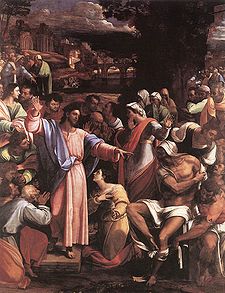
Italy
Italy , officially the Italian Republic languages]] under the European Charter for Regional or Minority Languages. In each of these, Italy's official name is as follows:;;;;;;;;), is a unitary parliamentary republic in South-Central Europe. To the north it borders France, Switzerland, Austria and...
Renaissance
Renaissance
The Renaissance was a cultural movement that spanned roughly the 14th to the 17th century, beginning in Italy in the Late Middle Ages and later spreading to the rest of Europe. The term is also used more loosely to refer to the historical era, but since the changes of the Renaissance were not...
-Mannerist
Mannerism
Mannerism is a period of European art that emerged from the later years of the Italian High Renaissance around 1520. It lasted until about 1580 in Italy, when a more Baroque style began to replace it, but Northern Mannerism continued into the early 17th century throughout much of Europe...
painter of the early 16th century famous for his combination of the colors of the Venetian school
Venetian school (art)
-Context:In the 15th century Venetian painting developed through influences from the Paduan School and Antonello da Messina, who introduced the oil painting technique of Early Netherlandish painting. It is typified by a warm colour scale and a picturesque use of colour...
and the monumental forms of the Roman school.
Biography
Sebastiano del Piombo belongs to the painting school of his native city, VeniceVenice
Venice is a city in northern Italy which is renowned for the beauty of its setting, its architecture and its artworks. It is the capital of the Veneto region...
, but was active for a large portion of his career in Rome. At first a musician, chiefly a soloist on the lute, he was in great request among the Venetian nobility. He soon showed a turn for painting, and became a pupil of Giovanni Bellini
Giovanni Bellini
Giovanni Bellini was an Italian Renaissance painter, probably the best known of the Bellini family of Venetian painters. His father was Jacopo Bellini, his brother was Gentile Bellini, and his brother-in-law was Andrea Mantegna. He is considered to have revolutionized Venetian painting, moving it...
and afterwards of Giorgione
Giorgione
Giorgione was a Venetian painter of the High Renaissance in Venice, whose career was cut off by his death at a little over thirty. Giorgione is known for the elusive poetic quality of his work, though only about six surviving paintings are acknowledged for certain to be his work...
, whose influence is apparent in his works. Some of Sebastiano's works were indeed confused with Giorgione's, i.e. the Salomè
Salome
Salome , the Daughter of Herodias , is known from the New Testament...
of 1510.
His first painting of note was done for the church of San Giovanni Crisostomo, Venice
San Giovanni Crisostomo, Venice
San Giovanni Grisostomo is a small church in the sestiere or neighborhood of Cannaregio, Venice.The church was founded in 1080, destroyed by fire in 1475, then rebuilt starting in 1497 by Mauro Codussi and his son, Domenico. Construction was completed in 1525. The campanile dates from the late...
, and is so closely modeled on the style of Giorgione that in its author's time it often passed for the work of that master. It represents Saint John Chrysostom
John Chrysostom
John Chrysostom , Archbishop of Constantinople, was an important Early Church Father. He is known for his eloquence in preaching and public speaking, his denunciation of abuse of authority by both ecclesiastical and political leaders, the Divine Liturgy of St. John Chrysostom, and his ascetic...
reading aloud at a desk, a grand Magdalene in front, and two other female and three male saints.
Roman works
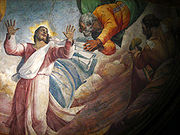
Galatea (Raphael)
The Triumph of Galatea is a fresco masterpiece completed in 1512 by the Italian painter Raphael for the Villa Farnesina in Rome.The Farnesina was built for the Sienese banker Agostino Chigi, one of the richest men of that age. The Farnese family later acquired and renamed the villa, smaller than...
in the villa now-called the Farnesina
Villa Farnesina
The Villa Farnesina is a Renaissance suburban villa in the Via della Lungara, in the district of Trastevere in Rome, central Italy.The villa was built for Agostino Chigi, a rich Sienese banker and the treasurer of Pope Julius II. Between 1506–1510, the Sienese artist and pupil of Bramante,...
. There he would have worked alongside Raphael
Raphael
Raffaello Sanzio da Urbino , better known simply as Raphael, was an Italian painter and architect of the High Renaissance. His work is admired for its clarity of form and ease of composition and for its visual achievement of the Neoplatonic ideal of human grandeur...
, and executed some mythology
Greek mythology
Greek mythology is the body of myths and legends belonging to the ancient Greeks, concerning their gods and heroes, the nature of the world, and the origins and significance of their own cult and ritual practices. They were a part of religion in ancient Greece...
-inspired frescoes.
According to Vasari, Michelangelo
Michelangelo
Michelangelo di Lodovico Buonarroti Simoni , commonly known as Michelangelo, was an Italian Renaissance painter, sculptor, architect, poet, and engineer who exerted an unparalleled influence on the development of Western art...
befriended Sebastiano and offered pictorial designs for him to develop in paint. Four pictures for which this is claimed are the Pietà in the church of the Conventuali, Viterbo
Viterbo
See also Viterbo, Texas and Viterbo UniversityViterbo is an ancient city and comune in the Lazio region of central Italy, the capital of the province of Viterbo. It is approximately 80 driving / 80 walking kilometers north of GRA on the Via Cassia, and it is surrounded by the Monti Cimini and...
; the Transfiguration and the Flagellation in the Borgherini Chapel of the church of San Pietro in Montorio
San Pietro in Montorio
San Pietro in Montorio is a church in Rome, Italy, which includes in its courtyard The Tempietto built by Donato Bramante.-History:...
, Rome; and, most celebrated of all, the Raising of Lazarus, now in the National Gallery, London
National Gallery, London
The National Gallery is an art museum on Trafalgar Square, London, United Kingdom. Founded in 1824, it houses a collection of over 2,300 paintings dating from the mid-13th century to 1900. The gallery is an exempt charity, and a non-departmental public body of the Department for Culture, Media...
http://www.wga.hu/frames-e.html?/html/s/sebastia/lazarus.html. This grand work - more remarkable for general strength of pictorial perception than for qualities of detailed intellectual or emotional expression - is more than 3.5 by 2.5 meters, with the principal life-size figures transferred from wood to canvas in 1771. It was painted in 1517-1519 for Giulio de Medici, for the bishop of Narbonne, afterwards Pope Clement VII
Pope Clement VII
Clement VII , born Giulio di Giuliano de' Medici, was a cardinal from 1513 to 1523 and was Pope from 1523 to 1534.-Early life:...
; and it remained in Narbonne cathedral until purchased by the duke of Orleans early in the eighteenth century, coming to England
England
England is a country that is part of the United Kingdom. It shares land borders with Scotland to the north and Wales to the west; the Irish Sea is to the north west, the Celtic Sea to the south west, with the North Sea to the east and the English Channel to the south separating it from continental...
with the Orleans Collection
Orleans Collection
The Orleans Collection was a very important collection of over 500 paintings formed by the French prince of the blood Philippe d'Orléans, Duke of Orléans, mostly acquired between about 1700 and his death in 1723...
in 1792. It has been generally admitted that the design of Michelangelo
Michelangelo
Michelangelo di Lodovico Buonarroti Simoni , commonly known as Michelangelo, was an Italian Renaissance painter, sculptor, architect, poet, and engineer who exerted an unparalleled influence on the development of Western art...
appears in the figure of Lazarus and of those who are busied about him (two sketches of the Lazarus regarded as Michelangelo's handwork are now in the British Museum
British Museum
The British Museum is a museum of human history and culture in London. Its collections, which number more than seven million objects, are amongst the largest and most comprehensive in the world and originate from all continents, illustrating and documenting the story of human culture from its...
http://www.britishmuseum.org/research/search_the_collection_database/search_object_details.aspx?objectId=716128&partId=1; but whether he actually touched the panel, as has often been said, appears more than doubtful, as he left Rome
Rome
Rome is the capital of Italy and the country's largest and most populated city and comune, with over 2.7 million residents in . The city is located in the central-western portion of the Italian Peninsula, on the Tiber River within the Lazio region of Italy.Rome's history spans two and a half...
about the time when the picture was commenced. Raphael's
Raphael
Raffaello Sanzio da Urbino , better known simply as Raphael, was an Italian painter and architect of the High Renaissance. His work is admired for its clarity of form and ease of composition and for its visual achievement of the Neoplatonic ideal of human grandeur...
Transfiguration
Transfiguration (Raphael)
The Transfiguration is considered the last painting by the Italian High Renaissance master Raphael. It was left unfinished by Raphael, and is believed to have been completed by his pupil, Giulio Romano, shortly after Raphael's death in 1520...
was painted for the same patron and the same destination. The two works were exhibited together, and some admirers did not scruple to give the preference to Sebastiano.
His Flagellation of Christ
Flagellation of Christ
The Flagellation of Christ, sometimes known as Christ at the Column or the Scourging at the Pillar, is a scene from the Passion of Christ very frequently shown in Christian art, in cycles of the Passion or the larger subject of the Life of Christ. It is the fourth station of the modern alternate...
, though ordinarily termed a fresco
Fresco
Fresco is any of several related mural painting types, executed on plaster on walls or ceilings. The word fresco comes from the Greek word affresca which derives from the Latin word for "fresh". Frescoes first developed in the ancient world and continued to be popular through the Renaissance...
, is, according to Vasari
Giorgio Vasari
Giorgio Vasari was an Italian painter, writer, historian, and architect, who is famous today for his biographies of Italian artists, considered the ideological foundation of art-historical writing.-Biography:...
, painted in oil upon the wall. This was a method first practiced by Domenico Veneziano
Domenico Veneziano
Domenico Veneziano was an Italian painter of the early Renaissance, active mostly in Perugia and Tuscany.Little is known of his birth, though he is thought to have been born in Venice, hence his last name. He then moved to Florence in 1422-23 as a boy, to become a pupil of Gentile da Fabriano. He...
, and afterwards by other artists; but Sebastiano alone succeeded in preventing the blackening of the colours. The design for the figure of Christ in this picture is supposed by many to have been supplied by Michelangelo
Michelangelo
Michelangelo di Lodovico Buonarroti Simoni , commonly known as Michelangelo, was an Italian Renaissance painter, sculptor, architect, poet, and engineer who exerted an unparalleled influence on the development of Western art...
. Sebastiano, always a tardy worker, was occupied about six years upon this work, along with its companion the Transfiguration, and the allied figures of saints.
Elevation to office of Piombo
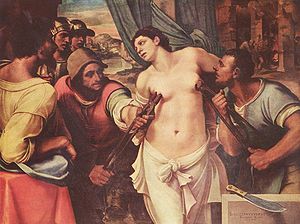
Giulio de' Medici
Giulio de' Medici may refer to:*Pope Clement VII, Giulio di Giuliano de' Medici, *Giulio di Alessandro de' Medici , illegitimate son of the last ruler of Florence from the "senior" branch of the Medici, Alessandro de' Medici...
to the pontificate, the office of the piombo (or leaden seal) that is, the office of sealer of briefs of the apostolic chamber became vacant; two painters competed for it, Sebastiano Luciani, hitherto a comparatively poor man, and Giovanni da Udine
Giovanni da Udine
Giovanni Nanni, also Giovanni de' Ricamatori, better known as Giovanni da Udine , was an Italian painter and architect born in Udine....
. Sebastiano, assuming the habit of a friar, secured the very lucrative appointment with the proviso that he should pay out of his emoluments 300 scudi per annum to Giovanni. The name "del Piombo" came from this office. If he had heretofore been slow in paintings he became now supine in a marked degree.
One of the few subject-pictures which he executed after taking office was Christ carrying the Cross for the patriarch of Aquileia
Aquileia
Aquileia is an ancient Roman city in what is now Italy, at the head of the Adriatic at the edge of the lagoons, about 10 km from the sea, on the river Natiso , the course of which has changed somewhat since Roman times...
, also a Madonna with the body of Christ. The former painting is done on stone, a method invented by Sebastiano himself. He likewise painted at times on slate-as in the instance of Christ on the Cross, now in the Berlin gallery, where the slate constitutes the background. In the same method, and also in the same gallery, is the Dead Christ supported by Joseph of Arimathea
Joseph of Arimathea
Joseph of Arimathea was, according to the Gospels, the man who donated his own prepared tomb for the burial of Jesus after Jesus' Crucifixion. He is mentioned in all four Gospels.-Gospel references:...
, with a weeping Magdalene
Magdalene
Magdalene or Magdalen may refer to:*Mary Magdalene, a disciple of Jesus*Magdalene , a feminine given name *Magdalene , a character in Marvel Comics...
colossal half-length figures.
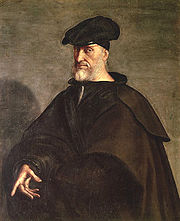
Michelangelo
Michelangelo di Lodovico Buonarroti Simoni , commonly known as Michelangelo, was an Italian Renaissance painter, sculptor, architect, poet, and engineer who exerted an unparalleled influence on the development of Western art...
with reference to the Florentine's great picture of the Last Judgment
The Last Judgment (Michelangelo)
The Last Judgment is a canonical fresco by the Italian Renaissance master Michelangelo executed on the altar wall of the Sistine Chapel in Vatican City...
. Sebastiano encouraged the pope to insist that this picture should be executed in oil. Michelangelo, determined from the first upon nothing but fresco, tartly replied to his holiness that oil was only fit for women and for sluggards like Friar Sebastian; and the coolness between the two painters lasted almost up to the friar's death. This event, consequent upon a violent fever acting rapidly upon a very sanguine temperament, took place in Rome
Rome
Rome is the capital of Italy and the country's largest and most populated city and comune, with over 2.7 million residents in . The city is located in the central-western portion of the Italian Peninsula, on the Tiber River within the Lazio region of Italy.Rome's history spans two and a half...
in 1547. Sebastiano directed that his burial, in the church of Santa Maria del Popolo
Santa Maria del Popolo
Santa Maria del Popolo is an Augustinian church located in Rome, Italy.It stands to the north side of the Piazza del Popolo, one of the most famous squares in the city. The Piazza is situated between the ancient Porta Flaminia and the park of the Pincio...
, should be conducted without ceremony of priests, friars or lights, and that the cost thus saved should go to the poor.
He died at Rome in 1547.
Numerous pupils sought training from Sebastiano del Piombo; but, owing to his dilatory and self-indulgent habits, few adapted his style with the exception of Tommaso Laureti
Tommaso Laureti
Tommaso Laureti, often called Tommaso Laureti Siciliano , was an Italian painter from Sicily who trained in the atelier of the aged Sebastiano del Piombo and worked in Bologna...
. Sebastiano, conscious of his deficiency in the higher sphere of invention, made himself especially celebrated as a portrait painter: the likeness of Andrea Doria
Andrea Doria
Andrea Doria was an Italian condottiere and admiral from Genoa.-Early life:Doria was born at Oneglia from the ancient Genoese family, the Doria di Oneglia branch of the old Doria, de Oria or de Auria family. His parents were related: Ceva Doria, co-lord of Oneglia, and Caracosa Doria, of the...
, in the Doria Palace
Doria Pamphilj Gallery
The Doria Pamphilj Gallery is a large art collection housed in the Palazzo Doria Pamphilj in Rome, Italy. It is situated between the Via del Corso and Via della Gatta. The principal entrance is on the Via del Corso...
, Rome
Rome
Rome is the capital of Italy and the country's largest and most populated city and comune, with over 2.7 million residents in . The city is located in the central-western portion of the Italian Peninsula, on the Tiber River within the Lazio region of Italy.Rome's history spans two and a half...
, is one of the most renowned. In the National Gallery, London
National Gallery, London
The National Gallery is an art museum on Trafalgar Square, London, United Kingdom. Founded in 1824, it houses a collection of over 2,300 paintings dating from the mid-13th century to 1900. The gallery is an exempt charity, and a non-departmental public body of the Department for Culture, Media...
, are two fine specimens; one canvas represents the friar himself, along with Cardinal Ippolito de' Medici
Ippolito de' Medici
Ippolito de' Medici was the illegitimate only son of Giuliano di Lorenzo de' Medici.Ippolito was born in Urbino. His father died when he was only five , and he was subsequently raised by his uncle Pope Leo X and his cousin Giulio.When Giulio de' Medici was elected pope as Clement VII, Ippolito...
; the other, a portrait of a lady in the character of St Agatha, used to be identified with one of Sebastiano's prime works, the likeness of Julia Gonzaga (painted for her lover, the aforenamed cardinal), but this assumption is now discredited. Other portraits include those of Marcantonio Colonna
Marcantonio Colonna
Marcantonio II Colonna , Duke and Prince of Paliano, was an Italian general and admiral.-Biography:...
, Vittoria Colonna
Vittoria Colonna
Vittoria Colonna , marchioness of Pescara, was an Italian noblewoman and poet.-Biography:The daughter of Fabrizio Colonna, grand constable of the kingdom of Naples, and of Agnese da Montefeltro, Vittoria Colonna was born at Marinoa fief of the Colonna family in the Alban Hills near Rome.Betrothed...
, Ferdinand marquis of Pescara
Pescara
Pescara is the capital city of the Province of Pescara, in the Abruzzo region of Italy. As of January 1, 2007 it was the most populated city within Abruzzo at 123,059 residents, 400,000 with the surrounding metropolitan area...
, Popes Adrian VI
Pope Adrian VI
Pope Adrian VI , born Adriaan Florenszoon Boeyens, served as Pope from 9 January 1522 until his death some 18 months later...
, Clement VII
Pope Clement VII
Clement VII , born Giulio di Giuliano de' Medici, was a cardinal from 1513 to 1523 and was Pope from 1523 to 1534.-Early life:...
and Paul III
Pope Paul III
Pope Paul III , born Alessandro Farnese, was Pope of the Roman Catholic Church from 1534 to his death in 1549. He came to the papal throne in an era following the sack of Rome in 1527 and rife with uncertainties in the Catholic Church following the Protestant Reformation...
, Sanmicheli, Anton Francesco degli Albizzi and Pietro Aretino
Pietro Aretino
Pietro Aretino was an Italian author, playwright, poet and satirist who wielded immense influence on contemporary art and politics and invented modern literate pornography.- Life :...
. One likeness of the last-named sitter is in Arezzo
Arezzo
Arezzo is a city and comune in Central Italy, capital of the province of the same name, located in Tuscany. Arezzo is about 80 km southeast of Florence, at an elevation of 296 m above sea level. In 2011 the population was about 100,000....
and another in the Berlin gallery.
Partial anthology of works
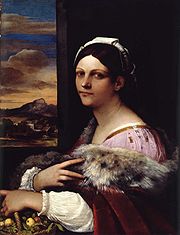
- Saint John Chrysostom (1509)
- PolyphemusPolyphemusPolyphemus is the gigantic one-eyed son of Poseidon and Thoosa in Greek mythology, one of the Cyclopes. His name means "much spoken of" or "famous". Polyphemus plays a pivotal role in Homer's Odyssey.-In Homer's Odyssey:...
(1511) - fresco, Villa FarnesinaVilla FarnesinaThe Villa Farnesina is a Renaissance suburban villa in the Via della Lungara, in the district of Trastevere in Rome, central Italy.The villa was built for Agostino Chigi, a rich Sienese banker and the treasurer of Pope Julius II. Between 1506–1510, the Sienese artist and pupil of Bramante,...
, RomeRomeRome is the capital of Italy and the country's largest and most populated city and comune, with over 2.7 million residents in . The city is located in the central-western portion of the Italian Peninsula, on the Tiber River within the Lazio region of Italy.Rome's history spans two and a half...
- The Metamorphosis (1511) - fresco, Villa FarnesinaVilla FarnesinaThe Villa Farnesina is a Renaissance suburban villa in the Via della Lungara, in the district of Trastevere in Rome, central Italy.The villa was built for Agostino Chigi, a rich Sienese banker and the treasurer of Pope Julius II. Between 1506–1510, the Sienese artist and pupil of Bramante,...
, RomeRomeRome is the capital of Italy and the country's largest and most populated city and comune, with over 2.7 million residents in . The city is located in the central-western portion of the Italian Peninsula, on the Tiber River within the Lazio region of Italy.Rome's history spans two and a half...
- Salome
- Martyrdom of St. Agatha - Palazzo PittiPalazzo PittiThe Palazzo Pitti , in English sometimes called the Pitti Palace, is a vast mainly Renaissance palace in Florence, Italy. It is situated on the south side of the River Arno, a short distance from the Ponte Vecchio...
, FlorenceFlorenceFlorence is the capital city of the Italian region of Tuscany and of the province of Florence. It is the most populous city in Tuscany, with approximately 370,000 inhabitants, expanding to over 1.5 million in the metropolitan area....
- Transfiguration and the Flagellation San Pietro in MontorioSan Pietro in MontorioSan Pietro in Montorio is a church in Rome, Italy, which includes in its courtyard The Tempietto built by Donato Bramante.-History:...
, RomeRomeRome is the capital of Italy and the country's largest and most populated city and comune, with over 2.7 million residents in . The city is located in the central-western portion of the Italian Peninsula, on the Tiber River within the Lazio region of Italy.Rome's history spans two and a half...
- Portrait of a Man (c. 1515) - Oil on poplar, 115 x 94 cm, Museum of Fine Arts, BudapestBudapestBudapest is the capital of Hungary. As the largest city of Hungary, it is the country's principal political, cultural, commercial, industrial, and transportation centre. In 2011, Budapest had 1,733,685 inhabitants, down from its 1989 peak of 2,113,645 due to suburbanization. The Budapest Commuter...
- Portrait of a Girl (c. 1515) - Oil on wood, 52,5 x 42,8 cm, Museum of Fine Arts, BudapestBudapestBudapest is the capital of Hungary. As the largest city of Hungary, it is the country's principal political, cultural, commercial, industrial, and transportation centre. In 2011, Budapest had 1,733,685 inhabitants, down from its 1989 peak of 2,113,645 due to suburbanization. The Budapest Commuter...
- Portrait of a Warrior (c. 1515)
- Madonna con il bambino e due evangelisti, olio su tela,73x127,1515 .Collezione privata.signor Sorino De Luca,Canada.
- PietàPietàThe Pietà is a subject in Christian art depicting the Virgin Mary cradling the dead body of Jesus, most often found in sculpture. As such, it is a particular form of the Lamentation of Christ, a scene from the Passion of Christ found in cycles of the Life of Christ...
(c. 1517) - Panel painting, Museo Civico, ViterboViterboSee also Viterbo, Texas and Viterbo UniversityViterbo is an ancient city and comune in the Lazio region of central Italy, the capital of the province of Viterbo. It is approximately 80 driving / 80 walking kilometers north of GRA on the Via Cassia, and it is surrounded by the Monti Cimini and...
, ItalyItalyItaly , officially the Italian Republic languages]] under the European Charter for Regional or Minority Languages. In each of these, Italy's official name is as follows:;;;;;;;;), is a unitary parliamentary republic in South-Central Europe. To the north it borders France, Switzerland, Austria and... - The Raising of LazarusRaising of Lazarus (Sebastiano del Piombo)The Raising of Lazarus is a large altarpiece by the Italian High Renaissance artist Sebastiano del Piombo. It is housed in the National Gallery of London, England....
(1519) National GalleryNational Gallery, LondonThe National Gallery is an art museum on Trafalgar Square, London, United Kingdom. Founded in 1824, it houses a collection of over 2,300 paintings dating from the mid-13th century to 1900. The gallery is an exempt charity, and a non-departmental public body of the Department for Culture, Media...
, LondonLondonLondon is the capital city of :England and the :United Kingdom, the largest metropolitan area in the United Kingdom, and the largest urban zone in the European Union by most measures. Located on the River Thames, London has been a major settlement for two millennia, its history going back to its...
- Portrait of Andrea DoriaPortrait of Andrea Doria (Del Piombo)The Portrait of Andrea Doria is a painting finished circa 1526 by the Italian High Renaissance painter Sebastiano Del Piombo. It is housed in the Doria Pamphilj Gallery of Rome....
(1526) Galleria Doria PamphiljDoria Pamphilj GalleryThe Doria Pamphilj Gallery is a large art collection housed in the Palazzo Doria Pamphilj in Rome, Italy. It is situated between the Via del Corso and Via della Gatta. The principal entrance is on the Via del Corso...
, RomeRomeRome is the capital of Italy and the country's largest and most populated city and comune, with over 2.7 million residents in . The city is located in the central-western portion of the Italian Peninsula, on the Tiber River within the Lazio region of Italy.Rome's history spans two and a half... - Portrait of Clement VII (1526) - Oil on Slate 105.4 x 87.6 cm Getty Museum, Los AngelesLos ÁngelesLos Ángeles is the capital of the province of Biobío, in the commune of the same name, in Region VIII , in the center-south of Chile. It is located between the Laja and Biobío rivers. The population is 123,445 inhabitants...
http://www.getty.edu/art/collections/objects/o1027.html - Birth of the Virgin (???) - Oil on peperino, Santa Maria del PopoloSanta Maria del PopoloSanta Maria del Popolo is an Augustinian church located in Rome, Italy.It stands to the north side of the Piazza del Popolo, one of the most famous squares in the city. The Piazza is situated between the ancient Porta Flaminia and the park of the Pincio...
, RomeRomeRome is the capital of Italy and the country's largest and most populated city and comune, with over 2.7 million residents in . The city is located in the central-western portion of the Italian Peninsula, on the Tiber River within the Lazio region of Italy.Rome's history spans two and a half... - Christ Bearing the Cross (1535–1540) - Oil on slate, 157 x 118 cm, Museum of Fine Arts, BudapestBudapestBudapest is the capital of Hungary. As the largest city of Hungary, it is the country's principal political, cultural, commercial, industrial, and transportation centre. In 2011, Budapest had 1,733,685 inhabitants, down from its 1989 peak of 2,113,645 due to suburbanization. The Budapest Commuter...
- Christ descending into Limbo - Prado Museum, MadridMadridMadrid is the capital and largest city of Spain. The population of the city is roughly 3.3 million and the entire population of the Madrid metropolitan area is calculated to be 6.271 million. It is the third largest city in the European Union, after London and Berlin, and its metropolitan...
http://museoprado.mcu.es/icuadro_noviembre_2002.html - Portrait of a Young Woman as a Wise Virgin (1510) National Gallery, Washington D.C.http://www.nga.gov/cgi-bin/pinfo?Object=41318+0+none
- Cardinal Bandinello Sauli, His Secretary, and Two Geographers (1516) National Gallery, Washington D.C.http://www.nga.gov/cgi-bin/pinfo?Object=45853+0+none
- Portrait of a Humanist (1520) National Gallery, Washington D.C.http://www.nga.gov/cgi-bin/pinfo?Object=45854+0+none
- A Prophet Addressed by an Angel (1516–17) National Gallery, Washington D.C.http://www.nga.gov/cgi-bin/pinfo?Object=64740+0+none
External links
- Sebastiano Luciani - La Piedad - Fundación Casa Ducal de Medinaceli
- The first monographic exhibition of Sebastiano del Piombo - Palazzo Venezia, Rome (Italy) - from 7th february to 18th may 2008
- Strinati C., Sebastiano del Piombo 1485-1547, 24 ORE Cultura, Milano 2008, ISBN 978-88-7179-576-8

